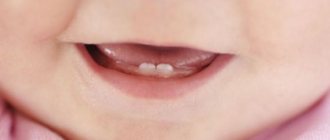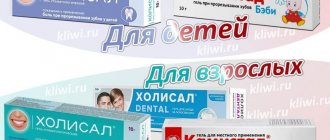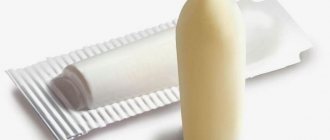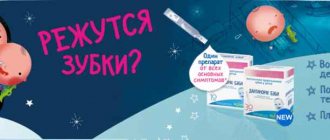There are restrictions during pregnancy
Has restrictions when breastfeeding
Has restrictions for children
Can be taken by older people
Can be taken for liver problems
Can be taken for kidney problems
For the treatment of inflammatory and infectious diseases of the oral cavity, it is most rational to use local drugs. Cholisal is a popular and effective gel that belongs to the group of non-steroidal anti-inflammatory drugs and is used in dentistry. It is prescribed for the following pathologies:
- candidiasis and other fungal infections;
- stomatitis of various etiologies, including bacterial;
- cheilitis;
- periodontitis;
- ulcers and erosions of mucous membranes.
The drug can be used as a local anesthetic during dental and minor surgical procedures in the oral cavity, as well as to alleviate the condition in children during teething.
Composition of the drug
Cholisal contains two active ingredients:
- Choline salicylate is a derivative of acetylsalicylic acid. Has an analgesic effect. When applied topically, it helps to quickly get rid of signs of inflammation such as pain, swelling, and redness. The mechanism of action is associated with blocking the activity of the enzymes cyclooxygenase and thromboxane synthetase, which take part in the synthesis of inflammatory mediators - prostaglandins and leukotrienes.
- Cetalkonium chloride is a broad-spectrum antiseptic. Most bacteria, viruses and fungi are sensitive to it.
Cholisal has a gel base, which adheres well to the mucous membrane and is not destroyed by salivary enzymes. The drug is produced in Poland. The price of this drug is quite high and, if necessary, Cholisal is replaced with one of the cheaper analogues.
Pharmacology and pharmacodynamics
The medication has an antimicrobial effect and also has anti-inflammatory and analgesic effects.
The active ingredient choline salicylate relieves pain and inflammation at the site of application of the gel. The analgesic effect lasts for an average of 4-7 hours.
The second active element has a powerful antiseptic effect. Effectively copes with harmful bacteria.
The structure of the ointment promotes its rapid absorption into tissues, reaches the nerve endings in a short time and remains on the oral mucosa for a long time. Almost does not enter the blood.
Authorized Products
The diet for stomatitis in children includes certain foods that do not irritate the oral mucosa.
Proper nutrition includes:
- Vegetables (boiled, baked, steamed) - dishes made from them do not injure, do not irritate, and at the same time provide the body with vitamins and minerals. It is recommended to take vegetables with a delicate structure (broccoli, zucchini, potatoes, pumpkin).
- Fermented milk drinks and products should definitely be included in the child’s diet, but they should not contain a lot of acid. It is worth giving preference to soft neutral cottage cheese, Varenets, and fermented baked milk.
- Cereals - they are used to prepare porridges. They have an enveloping effect. They provide the body with B vitamins. The cereal must be well boiled.
- Fruits – usually choose moderately sweet, neutral, non-acidic fruits. It is better to take bananas, watermelons, melons, crumbly sweet varieties of apples and pears.
- Fish dishes - for their preparation, it is advisable to use fatty varieties of sea fish. To prepare either minced fish or steam it, remove all the bones so that the baby cannot injure the oral mucosa. Fish is a source of easily digestible protein, vitamins, microelements and polyunsaturated fatty acids.
- Meat dishes - only soft, lean types (veal, rabbit, chicken, turkey) are used to prepare them. When cooking, it is better to prepare minced meat products. Steam them or bake them in the oven. You can cook: soufflé, cutlets, meatballs.
- Liver - it can sometimes replace meat dishes; it is also better for preparing cutlets, soufflés, pates and similar dishes.
- Casseroles - can be prepared from vegetables, cereals, pasta, cottage cheese.
- Soups and broths – puree soups and low-fat broths are widely used in dietary nutrition.
- Soft cheeses are a good source of calcium. It is high in calories, easily digestible, and nutritious.
- Dried fruit compotes and jelly are a source of vitamins and microelements. It is better to replace tea with these drinks.
- Juices must be natural, freshly squeezed. To do this, it is better to take non-acidic fruits and vegetables (pears, apples, carrots).
The use of these products in a diet for stomatitis will make the diet high in calories and nutritious, at the same time gentle.
What does Cholisal help with?
The gel is able to cope with inflammatory processes occurring in the oral cavity and various injuries. The drug should be taken for the following conditions:
- stomatitis;
- mechanical injuries and other damage resulting from wearing prostheses;
- for severe pain, as well as for prophylactic purposes after dental surgery;
- teething in babies;
- gingivitis.
Instructions for use
Although different gels have individual application characteristics (permissible frequency of application, number of repeated applications), they are all used for the same purpose, in the same way. A small amount of gel is distributed over the surface of the gums, from which the child’s new teeth are erupting.
As you can see, this procedure is very simple, but even so, recommendations for the use of a particular gel for various symptoms should be taken into account. For example, using an anesthetic gel during teething, if there is no fever, is not always necessary, but this is necessary in the case when, in addition to fever, other symptoms, especially pain, are pronounced.
And remember, only your pediatrician can correctly prescribe a teething gel!
How to use Cholisal gel
The instructions indicate that the ointment is for external use only. It should be applied exclusively to the affected area of the mouth.
The product should be applied 20 minutes before or after meals. You can also rub the ointment in before going to bed. The procedure can be repeated up to 3 times a day. It will be enough for a child to use 0.5 cm, and for an adult – 1 cm.
If a person suffers from periodontal disease, then the ointment can be placed in the gum pockets that appear or effective compresses can be made.
Adverse reactions and overdose
In some cases, after direct contact of the oral mucosa and the ointment, undesirable reactions may occur in the form of a burning sensation and tingling sensation. Such reactions are normal and disappear on their own after a few minutes. In rare cases, allergies may occur.
If serious side effects occur, you should stop using the gel and tell your doctor.
There are no cases of drug overdose. The ointment should not be swallowed; it is intended for external use only. If part of the medicine gets inside, then you need to rinse the stomach and, if necessary, begin symptomatic treatment.
Insidious periodontitis: crept up unnoticed, left without a tooth
Periodontitis is the next stage of inflammation after pulpitis. The infection is localized at the apex of the tooth root and surrounding tissues. The disease is often asymptomatic, but without timely help it leads to tooth loss.
Causes:
- Untreated pulpitis. If a tooth hurts and then stops, it means that the inflammation has entered a chronic stage. Chronic pulpitis will slowly spread throughout the tooth and turn into periodontitis.
- Pulpitis treated using outdated methods. Before the advent of the apex locator, there was nothing to measure the length of the root canal, and the doctor acted blindly. If the canal is not completely treated and particles of infected pulp remain in it, complications arise. To avoid this, the doctor may have overdone it and brought the dental material beyond the root apex. Over the years, a focus of infection sometimes develops around a lump of paste.
- Tooth injury. A common problem in active children. Due to injury (the incisors are often affected), the pulp dies, and periodontitis develops after this. In fact, the reason is the same pulpitis that was not noticed and not treated in time.
Types of periodontitis
| Form | View | How it hurts |
| Spicy | Serous | Mild aching pain in the tooth area. |
| Purulent | Throbbing pain. Tooth mobility may increase. Possible swelling of the cheek, weakness, fever, flux. | |
| Chronic | Fibrous | No symptoms or slight darkening, dull color of the crown of the tooth. |
| Granulating | Mild pain when biting eventually turns into pain from heat, chewing, or pressure. The gums become red and swollen. | |
| Granulomatous | No symptoms. A fistula appears to drain the discharge, but the patient cannot always see it. |
The most aggressive is granulating periodontitis, which very quickly spreads to neighboring tissues. With this diagnosis, most often the tooth cannot be saved.
In the granulomatous type of the disease, the inflammation site has a hard shell, and inside it is filled with pus. Depending on the size, these neoplasms are called granuloma (up to 5 mm), cystogranuloma or radicular cyst (more than 1 cm).
Thus, granuloma and tooth root cyst are manifestations of chronic periodontitis.
Diagnostics
Do not confuse fistula with stomatitis. The fistula looks like a pimple, is located on the gum near the roots of the tooth, and does not hurt when pressed. If a fistula appears, contact your dentist as soon as possible.
The doctor can suspect a problem before the formation of a fistula or gumboil based on complaints. It is very important that the patient describes all the symptoms and does not hesitate to complain about mild, unexpressed, occasional pain and discomfort.
X-rays help to accurately establish the diagnosis. Periodontitis is visible even on a small targeted photograph. Next, to plan treatment, the dentist will suggest taking a panoramic image (all teeth in one frame) or a computer tomogram (a three-dimensional image of the dental system).
CT - 3D computer tomogram
allows you to see the type of periodontitis, the location and size of cystogranuloma, and give a prognosis for treatment.
Positive dynamics
visible on a repeat tomogram 2 years later
From all sides
The advantage of CT is the ability to examine the tooth and the tissue around it from different angles
Treatment
Depending on the stage and form of the disease, the doctor will select the optimal method.
1. Therapeutic treatment. Typically, three visits to the dental office are required.
- Urgent Care. The dentist will remove the source of inflammation: clean and disinfect the canals using medications and laser sterilization. If necessary, the doctor will install a drainage to drain the pus.
- Treatment of tooth canals and installation of a temporary filling. If there are doubts that the immune system will cope with the remaining microorganisms, the dentist may prescribe antibiotics, physiotherapy, rinses and medicinal baths.
- Tooth restoration. At the last visit, the dentist will take an x-ray to make sure that the inflammation has been removed. After this, you can begin filling and restoring the aesthetics and chewing function of the tooth.
- Observation. We can talk about the positive dynamics of the tissues surrounding the tooth after 1-2 years based on the results of an x-ray examination.
2. Tooth-preserving operations. Sometimes conservative methods are not enough. A dental surgeon can perform a cystectomy (removal of the cyst) or apex resection (cutting off part of the tooth along with the cyst).
3. Tooth extraction. In advanced stages, it will not be possible to completely defeat foci of infection. Attempts to save a tooth will lead to large financial expenses and jeopardize neighboring teeth. The best solution would be to install an implant in place of the affected tooth.
If a tooth is left without treatment, it will be removed prematurely. The inflammation will grow and go into an acute stage, and at the most unfortunate moment.
Doctors call chronic periodontitis a ticking time bomb. Exacerbation is provoked by stress, exertion, hypothermia or climate change. That is, it will happen on a long-awaited trip to the sea, while working on an important project, before an exam, or during an infectious disease.
Periodontitis in children
In a child, periodontal inflammation can develop on both milk and permanent teeth. Features of childhood periodontitis:
- high flow rate,
- severe symptoms (temperature, pain, swelling, possible suppuration),
- increased risk of complications. If urgent measures are not taken, the rudiments of permanent teeth will suffer.
Treatment follows the same scheme as for adults. If there is less than a year left before a baby tooth falls out or the roots have already resolved, the pediatric dentist will suggest removing the tooth.
Prevention
Simple and inexpensive measures will reduce the risks of periodontitis and tooth loss.
- Maintain good oral hygiene.
- Eat right. Excess carbohydrate foods provoke the development of pathogenic microorganisms.
- Contact a specialist for dental treatment in a timely manner. Come for a routine examination every six months, even if nothing hurts. Voice all complaints.
- Treat with understanding the doctor’s suggestion to undergo a panoramic radiography or computed tomography. Complete information will allow you to notice and cure the disease.
For expert assistance in writing the article and providing examples of work, we thank dentist-therapist Olga Yuryevna Yuryeva.
Reviews about Cholisal
Most reviews about the use of the drug by adults and children are positive. The gel is able to quickly and effectively eliminate pain and inflammation and cools the affected area. If you use the medicine at night, the effect will last almost until the morning. Also has an antipyretic effect. For many, the advantage is that the composition does not contain lidocaine, to which many have adverse reactions and allergies.
There are many rave reviews from patients who had stomatitis. Within 3-5 minutes after application, you can notice a significant improvement in the condition, pain disappears, and after 15-20 minutes the inflammation is relieved. If you apply compresses before bed, then after a couple of days the signs of stomatitis will almost completely disappear.
The gel is sold in pharmacies. It can be bought without a doctor's prescription.










